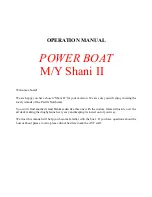
Boat Navigational Lights
Boats must display navigational lights when operating between
sunset and sunrise and during periods of reduced visibility, e.g.,
fog or rain, to alert other boats to their presence and course.
Although boat manufacturers usually provide lights to comply
with these rules, it is the operator’s responsibility to know and
comply with local laws.
Learn to recognize light groupings from different positions:
Masthead Light –
white light forward 8 o’clock to 4
o’clock (approximate)
Sidelight –
green light starboard 12 o’clock to 4 o’clock
(approximate); red light port 8 o’clock to 12 o’clock
(approximate)
Sternlight –
white light aft 4 o’clock to 8 o’clock
(approximate)
All-Round Light –
white light showing in all directions
Anchor Light –
white all-round light. Inland Rules
exempt boats in special anchorage areas.
Some other types of navigational lights include:
Sailboats operating under engine power must display the
same lights as other power-driven vessels.
Sailboats under sail only must display green and red
sidelights and a white sternlight, but not a white
masthead light. Boats under sail may display two all-
round lights, red over green, near the top of the mast.
Sailboats under 7 meters (23 feet) should display such
lights if possible, but if not, the boat must have an
electric torch or lighted lantern to show a white light in
time to prevent collision.
Commercial fishing vessels stopped while trawling must
display a green all-round light over a white all-round
light.
Commercial fishing vessels stopped while engaged in
other than trawling operations must display a red all-
round light over a white all-round light.
Towing vessels may display a yellow flashing or fixed
light.
Enforcement vessels may display a flashing blue light.
White strobe light is used as a distress signal.
3-6
















































